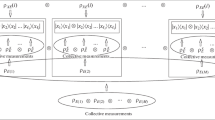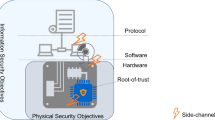Abstract
Quantum one-way function provides security for cryptographic protocols in quantum cryptography. Full quantum one-way function is a type of quantum one-way function that maps between quantum states and deals with pure quantum information. It was initially proposed by means of concatenating ‘quantum–classical’ and ‘classical–quantum’ quantum one-way functions. The first full quantum one-way function can be applied to quantum authentication, which uses quantum states to authenticate quantum states directly. However, the concatenation format restricts the implementation and cryptographic applications of this function. Considering the advantage of quantum circuit optimization in implementing quantum circuits to physical quantum devices, we propose a dynamic full quantum one-way function based on quantum circuit map**. Quantum circuit optimization intrinsically generates the remapped quantum circuit which maps between quantum states but does not destroy them. The dynamic process of quantum circuit map** contributes to the one-wayness of the dynamic full quantum one-way function. The experimental results show that this function is more realizable than the concatenated full quantum one-way function. The dynamic full quantum one-way function can be employed to construct a full quantum trapdoor one-way function which is ‘easy to compute and invert’ based on a trapdoor. Meanwhile, this new full quantum one-way function is proved to be very useful in quantum cryptography, especially in quantum currency notes. Our work promotes the development from full quantum one-way functions to future quantum cryptographic applications.








Similar content being viewed by others
Data availability
The data that support the findings of this study are available from the corresponding author upon reasonable request.
References
Goldreich, O.: Strong one-way functions. In: Foundations of Cryptography, 2nd ed., vol. 2, , pp. 32–33. Cambridge University Press, New York (2004)
Shor, P.W.: Polynomial-time algorithms for prime factorization and discrete logarithms on a quantum computer. SIAM Rev. 41(2), 303–332 (1999). https://doi.org/10.1137/S0036144598347011
Kashefi, E., Kerenidis, I.: Statistical zero knowledge and quantum one-way functions. Theor. Comput. Sci. 378, 101–116 (2005). https://doi.org/10.1016/j.tcs.2007.03.013
Hosoyamada, A., Yasuda, K.: Building quantum-one-way functions from block ciphers: Davies–Meyer and Merkle–Damgård constructions. In: IACR Cryptology ePrint Archive, vol. 2018, p. 841 (2018). https://doi.org/10.1007/978-3-030-03326-2_10
Ablayev, F., Vasiliev, A.: Cryptographic quantum hashing. Laser Phys. Lett. 11, 025202 (2014). https://doi.org/10.1088/1612-2011/11/2/025202
Ablayev, F., Ablayev, M.: On the concept of cryptographic quantum hashing. Laser Phys. Lett. 12, 125204 (2015). https://doi.org/10.1088/1612-2011/12/12/125204
Ablayev, F., Ablayev, M., Vasiliev, A., Ziatdinov, M.: Quantum fingerprinting and quantum hashing. Computational and cryptographical aspects. Balt. J. Mod. Comput. 4, 860–875 (2016). https://doi.org/10.22364/BJMC.2016.4.4.17
Ablayev, F., Ablayev, M., Vasiliev, A.: On the balanced quantum hashing. J. Phys. Conf. Ser. 681, 012019 (2016). https://doi.org/10.1088/1742-6596/681/1/012019
Buhrman, H., Cleve, R., Watrous, J., Wolf, R.: Quantum fingerprinting. Phys. Rev. Lett. 87, 167902 (2001). https://doi.org/10.1103/PhysRevLett.87.167902
Gottesman, D., Chuang, I.: Quantum digital signatures (2001). ar**v.quant-ph/0105032. https://doi.org/10.48550/ar**v.quant-ph/0105032
Behera, A., Paul, G.: Quantum to classical one-way function and its applications in quantum money authentication. Quantum Inf. Process. 17, 1–24 (2018). https://doi.org/10.1007/s11128-018-1965-z
Shang, T., Tang, Y., Chen, R., Liu, J.: Full quantum one-way function for quantum cryptography. Quantum Eng. 2, e32 (2020). https://doi.org/10.1002/que2.32
Preskill, J.: Quantum computing in the NISQ era and beyond. Quantum 2, 79 (2018). https://doi.org/10.22331/q-2018-08-06-79
Li, G., Ding, Y., ** problem for NISQ-era quantum devices. In: Proceedings of the 24th International Conference on Architectural Support for Programming Languages and Operating Systems (ASPLOS ’19), pp. 1001–1014. Association for Computing Machinery, New York (2019)
Siraichi, M., Santos, V., Collange, C., Pereira, F.: Qubit allocation. In: Proceedings of the 2018 International Symposium on Code Generation and Optimization (CGO 2018), pp. 113–125. Association for Computing Machinery, New York (2018)
Zulehner, A., Paler, A., Wille, R.: An efficient methodology for map** quantum circuits to the IBM QX architectures. IEEE Trans. Comput. Aided Des. Integr. Circuits Syst. 38, 1226–36 (2019). https://doi.org/10.1109/TCAD.2018.2846658
Akavia, A., Goldreich, O., Goldwasser, S., Moshkovitz, D.: On basing one-way functions on NP-hardness. In: Proceedings of the 38th Annual ACM Symposium on the Theory of Computing (STOC ’06), pp. 701–710. Association for Computing Machinery, New York (2006)
Shang, T., Chen, R., Liu, J.: On the obfuscatability of quantum point functions. Quantum Inf. Process. 18, 55 (2019). https://doi.org/10.1007/s11128-019-2172-2
Itoko, T., Raymond, R., Imamichi, T., Matsuo, A.: Optimization of quantum circuit map** using gate transformation and commutation. Integration 70, 43–50 (2020). https://doi.org/10.1016/j.vlsi.2019.10.004
Wiesner, S.: Conjugate coding. SIGACT News 15(1), 78–88 (1983). https://doi.org/10.1145/1008908.1008920
Aaronson, S., Farhi, E., Gosset, D., Hassidim, A., Kelner, J., Lutomirski, A.: Quantum money. Commun. ACM 55(8), 84–92 (2012). https://doi.org/10.1145/2240236.2240258
Jogenfors, J.: Quantum bitcoin: an anonymous, distributed, and secure currency secured by the no-cloning theorem of quantum mechanics. In: 2019 IEEE International Conference on Blockchain and Cryptocurrency (ICBC), pp. 245–52 (2019)
Lutomirski, A., Aaronson, S., Farhi, E., Gosset, D., Hassidim, A., Kelner, J., Shor, P.: Breaking and making quantum money: toward a new quantum cryptographic protocol. In: Proceedings of Innovations in Computer Science (ICS), pp. 20–31. Institute for Computer Science, Bei**g (2010)
Alagic, G., Fefferman, B.: On quantum obfuscation (2016). ar**v:1602.01771. https://doi.org/10.48550/ar**v.1602.01771
Floyd, R.: Algorithms 97: shortest path. Commun. ACM 5, 345 (1962). https://doi.org/10.1145/367766.368168
Zeng, G.H.: Reply to “Comment on ‘Arbitrated quantum-signature scheme’’’. Phys. Rev. A 78, 016301 (2008). https://doi.org/10.1103/PhysRevA.78.016301
García-Escartín, J., Chamorro-Posada, P.: swap test and Hong–Ou–Mandel effect are equivalent. Phys. Rev. A 87, 052330 (2013). https://doi.org/10.1103/PhysRevA.87.052330
Fanizza, M., Rosati, M., Skotiniotis, M., Calsamiglia, J., Giovannetti, V.: Beyond the swap test: optimal estimation of quantum state overlap. Phys. Rev. A 124, 060503 (2020). https://doi.org/10.1103/PhysRevLett.124.060503
Liu, W., Yin, H.: A quantum scheme of state overlap based on quantum mean estimation and support vector machine. Phys. A Stat. Mech. Appl. 606, 128117 (2022). https://doi.org/10.1016/j.physa.2022.128117
Cincio, L., Subaşl, Y., Sornborger, A.T., Coles, P.J.: Learning the quantum algorithm for state overlap. New J. Phys. 20, 113022 (2018). https://doi.org/10.1088/1367-2630/aae94a
Tang, Y., Shang, T., Liu, J.: Universal construction of a full quantum one-way function. Quantum Inf. Process. 21, 258 (2022). https://doi.org/10.1007/s11128-022-03586-7
Treinish, M., Gambetta, J., Nationand, P., et al.: Qiskit/qiskit: Qiskit 0.34.0 (0.34.0). Zenodo (2021)
Bergou, J.A., Hillery, M., Saffman, M.: Decoherence and quantum error correction. In: Quantum Information Processing. Graduate Texts in Physics. Springer, Cham (2021). https://doi.org/10.1007/978-3-030-75436-5_9
Acknowledgements
This project was supported by the National Natural Science Foundation of China (No. 61971021), the Key Research and Development Program of Hebei Province (No. 22340701D), and the Chinese Universities Industry-Education-Research Innovation Foundation of BII Education Grant Program (No. 2021BCA0200) for valuable helps.
Author information
Authors and Affiliations
Corresponding author
Ethics declarations
Conflict of interest
The authors declare that they have no conflict of interest.
Additional information
Publisher's Note
Springer Nature remains neutral with regard to jurisdictional claims in published maps and institutional affiliations.
Rights and permissions
Springer Nature or its licensor (e.g. a society or other partner) holds exclusive rights to this article under a publishing agreement with the author(s) or other rightsholder(s); author self-archiving of the accepted manuscript version of this article is solely governed by the terms of such publishing agreement and applicable law.
About this article
Cite this article
Tang, Y., Shang, T. & Liu, J. Dynamic full quantum one-way function based on quantum circuit map**. Quantum Inf Process 22, 324 (2023). https://doi.org/10.1007/s11128-023-04065-3
Received:
Accepted:
Published:
DOI: https://doi.org/10.1007/s11128-023-04065-3




